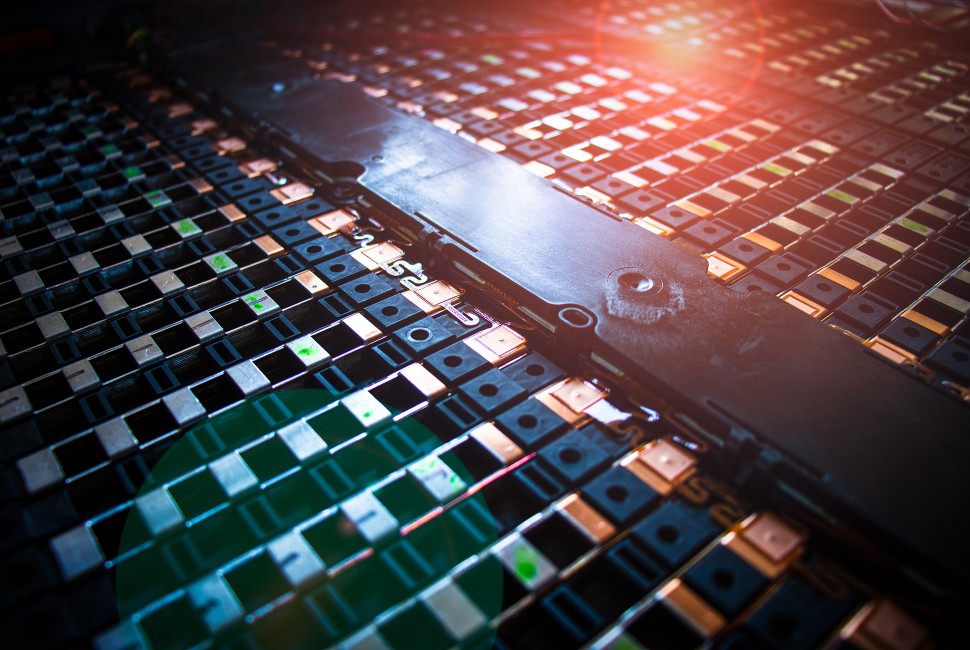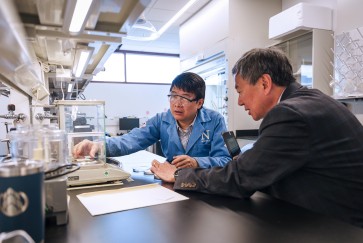This article is part of a series on companies in Northwestern’s Querrey InQbation Lab.
In the search for a better battery, researchers often describe the “Holy Grail” as a battery strong enough to power a car speeding cross country on a single charge.
But Mark Hersam is dreaming bigger than that.
Hersam — a Northwestern University professor, MacArthur “Genius” and founder of battery startup Volexion — imagines a future where batteries power long-distance semi-trucks, lumbering freight trains carrying tons of cargo and even airplanes circumnavigating the globe.
“I think battery-powered planes are coming,” said Hersam, a Walter P. Murphy Professor of Materials Science and Engineering at the McCormick School of Engineering. “Right now, we have drones powered by batteries. Drones are obviously very different from 747s, but they represent an important step in that direction. Battery-powered trucks are already in the works. Trains will follow, then planes.”
Of course, none of these revolutionary innovations will happen with the lithium-ion batteries currently available on the market. Not only do current batteries not hold enough charge to power long-range vehicles, they also take hours to recharge, lose capacity over time and — when pushed outside their stability range — can even go up in flames.
To approach these various challenges, Hersam’s team, along with researchers at Argonne National Laboratory, looked to the battery’s cathode.
Too high to handle
Lithium-ion batteries comprise three components: an anode (holds the lithium ions when charged), a cathode (holds the lithium ions when discharged) and an electrolyte (transports lithium ions). As the battery charges and discharges, the ions shuttle back and forth. When a battery is in use, ions travel from the anode to the cathode. And when the battery recharges, ions move from the cathode back to the anode.
Problems typically occur at the unstable interface between the electrolyte and the cathode. To give the battery high-energy density, the cathode operates at high voltages — higher voltages than the electrolyte can handle. This high voltage degrades the electrolyte, causing a film to build up on the cathode’s surface. The film creates a barrier for the ions as they attempt to travel back and forth, causing the battery’s capacity to fade over time. If the battery casing is compromised, even more catastrophic failure can occur, including the battery catching fire.
“It’s an unstable situation where all sorts of unwanted chemistry occurs,” Hersam said. “Those chemical reactions lead to decomposition of the electrolyte, making it harder to get lithium in and out of the cathode or the anode. The resulting film on the cathode surface compromises how much lithium can be stored and how quickly charging and discharging can occur. Electrolyte degradation also can cause safety problems that become even more severe at the high-energy densities required for operating large vehicles.”
Containing the cathode
An expert on two-dimensional materials, Hersam wondered if he could suppress unwanted degradation by coating a battery’s cathode with a protective layer of graphene. When he explored this technique, the outcome was dramatic.
By successfully encapsulating the cathode, Hersam’s technique resulted in a high-energy battery that lengthens driving range for electric vehicles, advances safety, improves sustainability and lowers cost. Not only does it last twice as long as a conventional battery, Hersam’s battery also packs in 30% more energy density and 40% more power density, compared to state-of-the-art technologies.
“Energy density determines the distance you can travel between charges,” Hersam explained. “But we also want to increase power density, which determines acceleration. So, you could have a vehicle that doesn’t accelerate quickly but has a long range. Or you could have a vehicle that’s really fast off the block but only goes 100 miles before needing to recharge. Ideally, you want a vehicle that accelerates quickly and has a long range.”
Encapsulating a cathode, however, is easier said than done.
Ideally, you want a vehicle that accelerates quickly and has a long range.”
Professor and Volexion founder
A cathode is not a monolithic material but a collection of micron-sized particles pressed into a dense film. In perhaps its most important innovation, Volexion discovered how to coat each particle with a scant layer of graphene. In a number of experiments, Hersam first mixed graphene with two solvents to create a stable emulsion. Then, he boiled the emulsion, causing the solvents to evaporate. Finally, the graphene collapsed to evenly coat each cathode particle.
“That’s how we get graphene exactly where we want it,” Hersam said. “If you have too much graphene in the solution, it will stack on top of itself to form large aggregates. You want as little graphene as possible. Otherwise, it’s just dead weight.”
The business of batteries
Working with Northwestern’s Innovation and New Ventures Office (INVO), Hersam spun out his invention into tech startup Volexion in 2018. A portmanteau of “velox” (the Latin root word of “velocity”) and “ion,” Volexion immediately captured investors’ attention, landing funds from two clean tech venture capital firms. In 2019 — just one year after launching — Volexion received the U.S. Department of Energy’s (DOE) “Ten at Ten” award, which honored 10 extraordinary technologies to celebrate the 10th anniversary of the DOE Energy Frontier Research Centers. Then, in 2021, the Nature Spinoff Prize named the startup as “one to watch.” The company also is actively engaged in collaborative work with multiple battery and automotive manufacturers.
Last fall, Volexion took yet another new step when it became one of the first resident startups to move into Northwestern’s Querrey InQbation Lab, located just off campus in downtown Evanston. Named in honor of Kimberly K. Querrey (’22, ’23 P), chair of the Innovation and Entrepreneurship Committee of Northwestern’s Board of Trustees, the InQbation Lab accelerates translation of research-driven innovation — promising to move it out of the lab and into the marketplace.
“Moving Volexion into the Querrey InQbation Lab has many, many advantages,” Hersam said. “It’s directly adjacent to campus, enabling us to use all the resources Northwestern has to offer. We can easily access equipment as well as world-class expertise, which enables us to solve problems more quickly and accelerate commercialization.”
A seasoned entrepreneur, Hersam says Volexion is working to scale up its technology and engage potential customers. Although different companies use different types of cathodes, the graphene coating works with any type of lithium-ion battery.
“Taking a technology to market and putting it into devices and vehicles that everyone uses really impacts society,” Hersam said. “With the Querrey InQbation Lab, Kimberly Querrey has created the infrastructure for that impact to increase dramatically. She is a true inspiration, who is ensuring that the fundamental science and engineering research that happens every day at Northwestern realizes its full commercial potential.”
Mark Hersam has a financial interest in and affiliation with Volexion. Northwestern University has financial interests (equities, royalties) in Volexion.
Northwestern’s Innovation and Entrepreneurship ecosystem strives to strengthen entrepreneurial activity by students and faculty and build a self-sustained and collaborative community that moves ideas beyond academia and into the market, generating innovations to benefit society.


